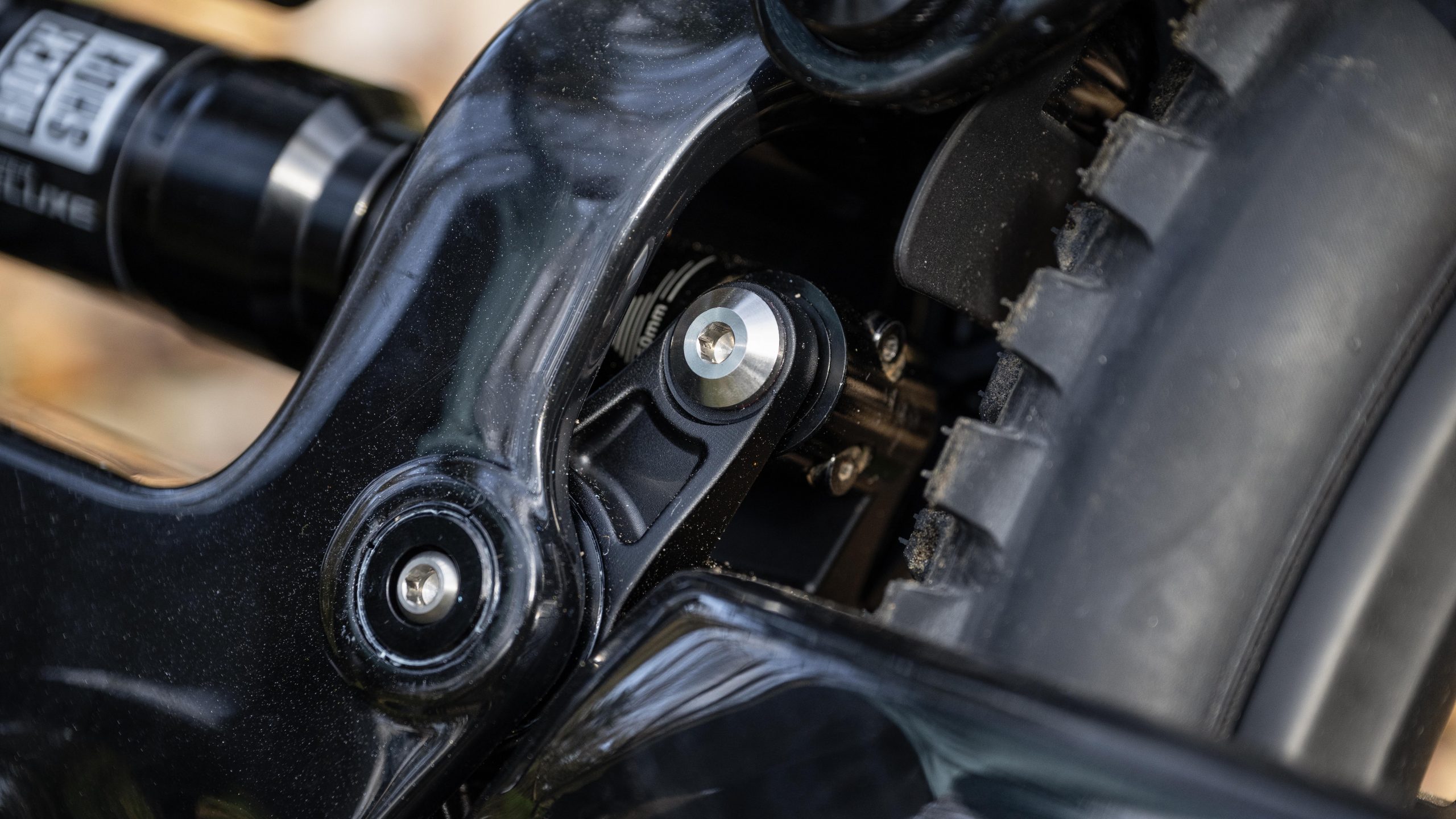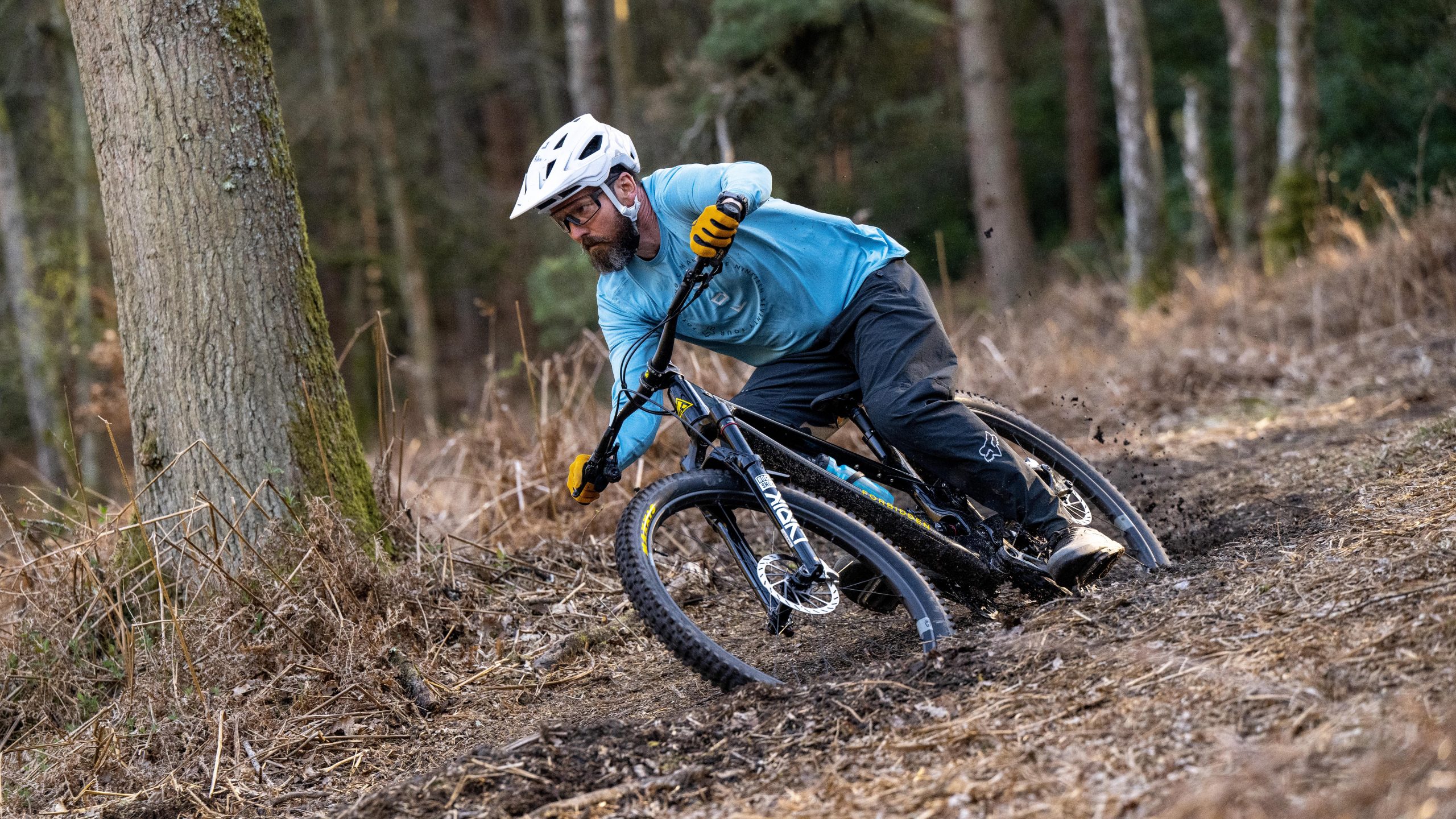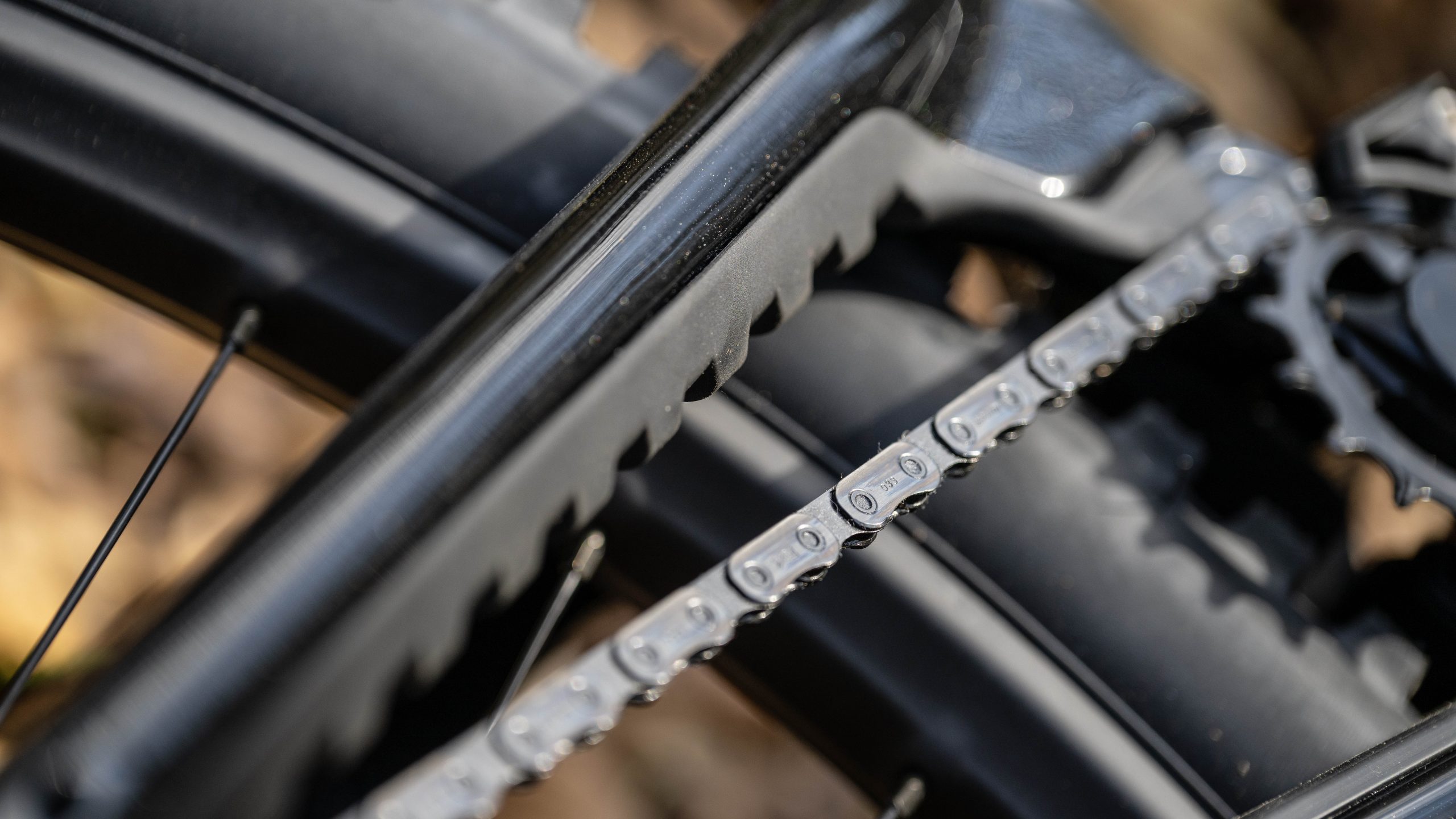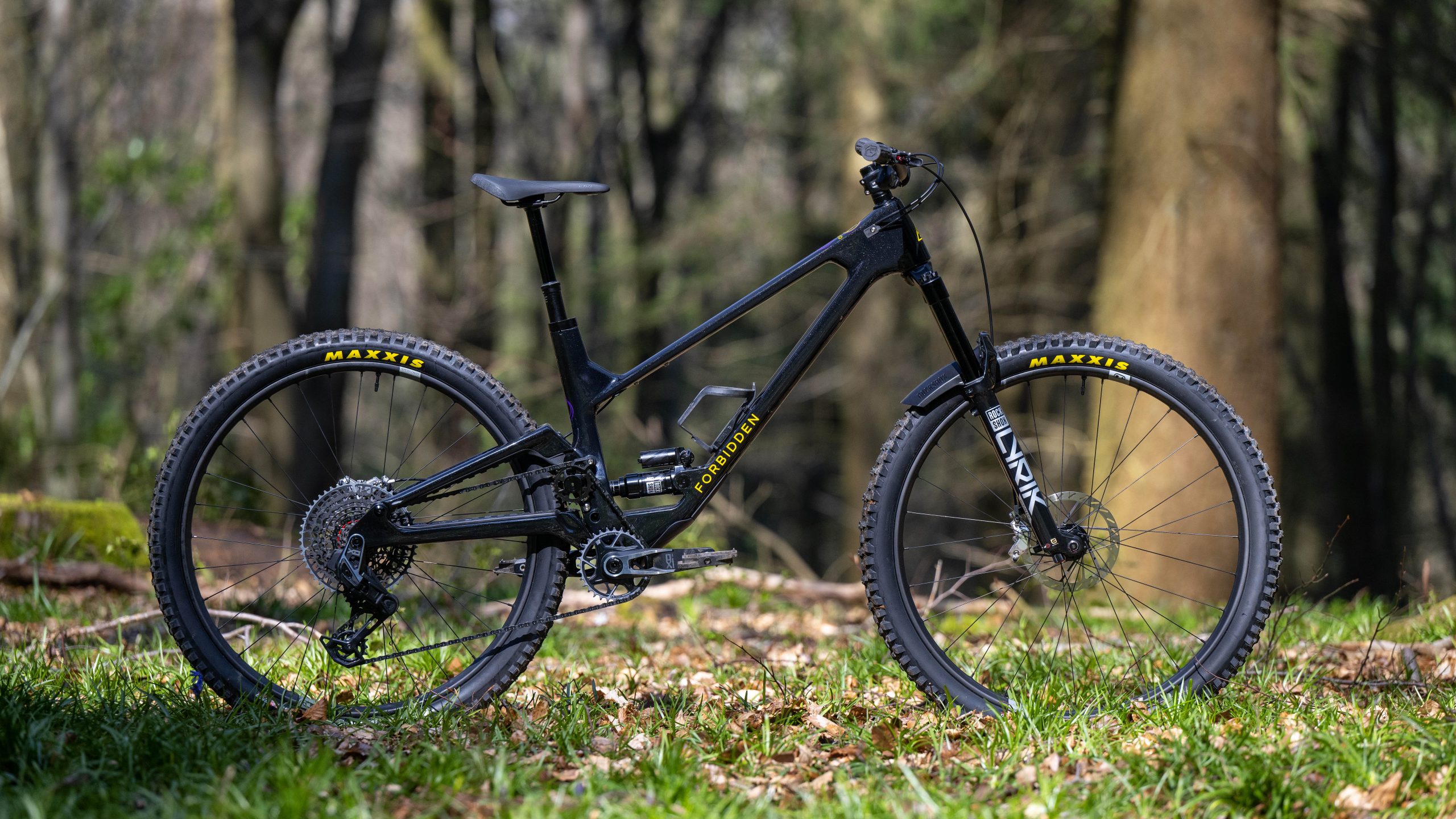Same concepts, new layout, impressive performance.
Forbidden Druid V2 X0 first ride review
One look at Forbidden’s currently unnamed downhill bike tells you everything you need to know about the direction the second generation Druid would take. Well, not quite everything, as not all of the features on the DH bike have trickled down to the trail bike, and for good reason.
Need to know:
- Full carbon trail bike with 29 or MX wheel options
- Druid V2 switches to an inveredt 4-bar design
- Frame travel is 130mm and it’s coupled with a 150mm fork
- Size specify and proportional rear centre measurement and rise specific handlebars on all four frame sizes.
- New locking collet axles and oversized bearings for improved durability
- Three models available
- RRP for Druid V2 X0 £8,999 / $8,899 / €10,599
But let’s deal with the elephant in the room first. The new Druid uses an inverted 4-bar suspension design to achieve the desired 130mm travel. It’s referred to as inverted, as the main pivot and Horst link form what’s traditionally seen as the seat stay assembly, rather than the chainstays, like on a regular 4-bar.

The Forbidden Druid V2 X0 being put through its paces by chief bike tester Alan Muldoon
The fundamental reason for the shift, is that the inverted 4-bar allows Forbidden to retain the key features of its Trifecta suspension philosophy, while achieving a more rearward idler position. Where the new idler position instantly increases the how much the chain wraps around the chainring, without the anti-rise numbers skyrocketing.
With more chain wrap, Forbidden has been able to ditch the lower chain guide to improve pedalling efficiency and reduce drivetrain noise. But has it worked? Yes, like a charm. In fact, you’d be hard pushed to tell you’re actually riding an idler bike without looking down at your feet. And for trail riding, that is a massive boon.

Dig a little deeper and it becomes clear that the move to a 4-bar is more of a side-step than a complete u-turn, as the fundamentals that make the Druid a Forbidden are all still in place. It still has a rearward axle path, it’s now 94% rearward rather than 100%, where it goes forward every so slightly at bottom out so there’s less chain tug on the derailleur from the lower portion of the drivetrain. You still get a similar amount of chainstay/rear centre growth at sag too, which makes dynamic rear centre measurement on the size large is about 12mm longer than the static 452mm chainstay length. And, much to my surprise, the Druid V2 is relatively easy to manual, because the bike feels very well balanced and more dynamic than before.

Anti-squat has also increased slightly and the progression rate has been modified too, to make the bike feel more dynamic. The overall leverage ratio has also been increased (slightly shorter stroke shock) which makes it easier for lighter rides running lower pressures to achieve a good set-up and gives Forbidden more shock tuning options in general. Add in the sag gradients on the RockShox Super Deluxe Ultimate, and getting a good set-up was easy, even though the shock is partially obscured by the frame.
The idler is now mounted to the front triangle, with a sturdy alloy mount and the cog is made from steel for improved durability. The tooth count has also been upped from 16t to 18t, which will also make it last longer. And Forbidden seems to have thought of everything. By making the idler cog asymmetric, it can be flipped to accommodate 52mm or 55mm chain lines. Also the idler mount has been angled ever so slightly so as you go up the cassette and put more torque through the cranks, the chainline is more direct which in turn reduces drivetrain noise.

This, combined with the clamped cable guides that keep the internally routing cables under tension, and ample rubber protection at all of the key touch points on the full carbon frame, makes for one of the quietest trail bikes I’ve ever ridden.
And while the focus on the new Druid will undoubtedly be on the new suspension layout, the changes to the geometry are also worth shouting about. I found the original size L Druid to be too short in reach and too tall in the headtube, both of which have been addressed with the latest design. The reach measurements on all four frame sizes have been increased by roughly 20mm to bring them inline with the Dreadnought and the sizing nomenclature has switched from S – XL to S1 – S4.
Forbidden has also steepened up the seat tube angle to 77º, and because the seat tubes on the size S3 and S4 aren’t offset from the BB, as the saddle height increases there is not the usual reduction in the effective seat tube angle, something taller riders will really appreciate.

As with all Forbidden bikes, the new Druid gets size specific chainstay lengths. More accurately, the growth in the rear centre measurement is engineered into the front triangle, and the upshot is that riders get the same weight distribution regardless of the frame size. Forbidden calls this its One Ride philosophy.
You also get to choose your preferred wheel size, Forbidden offering the Druid in full 29in or MX options. And instead of using the Ziggy link to adapt the bike’s geometry, the carbon chainstay assembly is swapped out. And just like on the old Druid the MX configuration has slightly different geometry, the bike 0.5º slacker and 5mm lower in BB height. Forbidden will offer either chain stay assembly aftermarket for riders wishing to make the switch at a later date, which is great, but maybe a flip-chip would have been an easier and more cost effective option.
How it rides
The geometry of the Druid V2 doesn’t look that radical on paper, but the suspension has been designed to run 35% sag at the shock, so the bike slackens out and sits in more than most. So even though the 337mm BB height may raise an eyebrow on a 130mm bike, it doesn’t feel high when you ride it, evident by the number of heel drags through tighter turns.

And while that makes it really fun to ride, it’s the Druid’s ability to achieve a set point in suspension and geometry without unwanted deviation from that point that really defines this bike. The higher than normal degree of anti-rise means the Druid literally digs its heels in and feels more composed than a 130mm travel bike really deserves to when trying to modulate speed down the steepest trails. So any theoretical loss in suspension response is more than compensated for by an increased sense of safety on what’s actually a pretty short travel trail bike.
Now, I don’t subscribe to the idea that having a more rearward axle path gives you more travel, because if all the travel was rearward, you’d have zero vertical travel and wouldn’t be able to absorb any bumps. However, I do believe that the reduction in chain growth associated with the idler on the Druid improves the overall ability of the suspension to do its job really effectively. And combined with a great sock tune the rear suspension on the Druid is very composed without ever feeling harsh.

But what’s really interesting is that it isn’t at the expense of pedalling efficiency. And just like when under braking, the Druid seems to take a suspension set at sag when you stomp on the pedals. As such, the shock doesn’t hyperextend like on bikes with too much anti-squat, nor does it bob or wallow. As such, Forbidden has absolutely nailed the ride quality of the Druid V2.

And because the brand has expanded its range of bikes, the Druid no longer has to be everything to all riders. With its new found laser sharp focus the Druid V2 is such an accomplished trail bike and so much better than its predecessor. There’s no adaptation time needed, or quirks of the design to ride around, the Druid V2 just feels like a really good trail bike that’s really easy to ride.
And I say that with absolute confidence, because rather than jetting off somewhere exotic for the launch, I got to ride the Druid V2 on the exact same tails that I’ve been testing bikes on for years and I left the launch impressed. Very impressed.
Looking for a new bike and not sure where to start? Our guide to the best mountain bikes will help. Or if it’s about the gear to help you ride better, more safely and have more fun, how about advice on the best mountain bike helmets or how to use bodyweight exercises to boost your MTB performance.
















